Dual shield welding is a semi-automatic arc welding process that is similar to flux-cored arc welding. This welding process also uses a continuous wire-fed electrode and constant-voltage welding power supply, but compared to FCAW, it also introduces external shielding gas.
As many welders asked why even use the dual shield welding process, we compiled this comprehensive article to explain it closely and discuss its pros and cons.
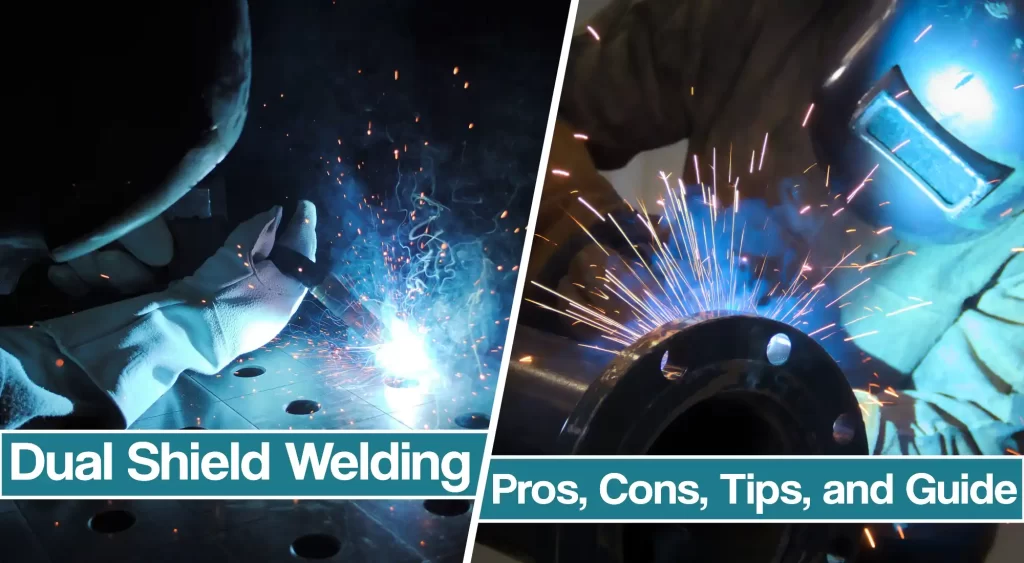
Is Dual shield welding the same as Flux-cored arc welding?
Fundamentally, the dual shield welding process is based on the flux-cored arc welding process, but as the name states, dual shield welding uses both shielding gas and FCAW electrodes. Therefore, the molten metal is protected from the environment by both a slag system and an external shielding gas.
ESAB was one of the manufacturers that pioneered the development of gas-shielded flux-cored arc welding in the 1950s. As a result, FCAW overcomes many of the restrictions associated with manual metal arc welding (stick welding) since it uses a continuously fed wire electrode.
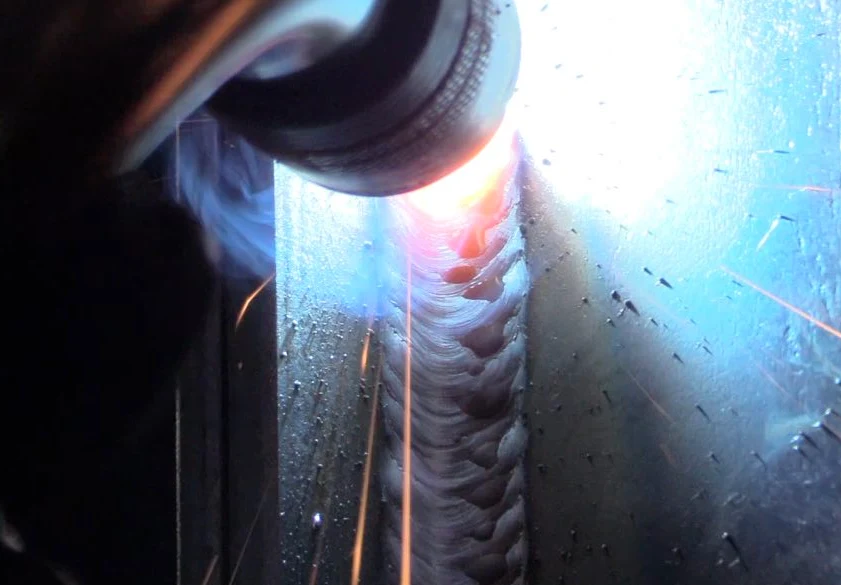
As a welder, you might have noticed some people refer to Flux core welding as dual shield welding. Dual shield welding combines electrodes from flux core arc welding and shielding gas for MIG welding. Let’s see how it works.
Basic Fundamentals of Dual shield welding
The dual shied welding process uses heat generated by an electric arc to fuse base metal in the weld joint area. As a result, an electric arc is formed between the workpiece and the continuously fed flux-cored wire. Due to heat caused by an electric arc, the wire and the base metal melt together to form a weld pool.
The wire adds the desired level of alloy elements to the puddle, which affects the structural properties of the weld metal. In addition, the filler metal produces a slag to coat the weld, which is courtesy of self-shielded wires.
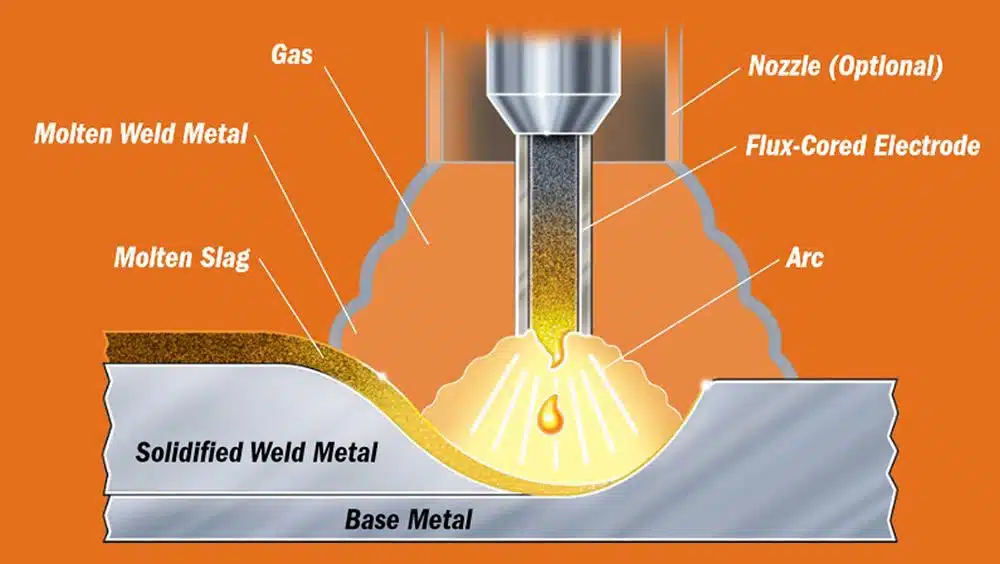
As the molten metal solidifies, it can react with gases in the atmosphere, eventually contaminating the weld. That’s where shielding gas provided externally plays a crucial role.
Most commonly, welders use 100% carbon dioxide (CO2) in the dual shielding process. That way, you will get excellent penetration and the ability to weld thicker metal.
As an alternative, you can use a mixture of 75 – 85% argon (Ar) and 15 – 25% Carbon Dioxide (CO2). Even though this is the most frequently used blend, it is more expensive. However, you get decent penetration with high-quality welds and higher deposition rates.
So you can deduce that the dual shield welding process utilizes the advantages of both MIG welding and Flux-cored arc welding, but welders still wonder: why do you use it?
Dual shield welding Applications
When talking about welding applications, Dual Shield Flux Core Arc Welding is similar to MIG/MAG welding and Stick Welding. The process is most often manual, but welders can automate it depending on the nature of the welding job.
Overall, this is a flexible welding process suitable for all position welding, given the correct filler material and flux composition. In addition, due to high deposition rates, it is highly productive and provides high-quality welds with a good appearance.
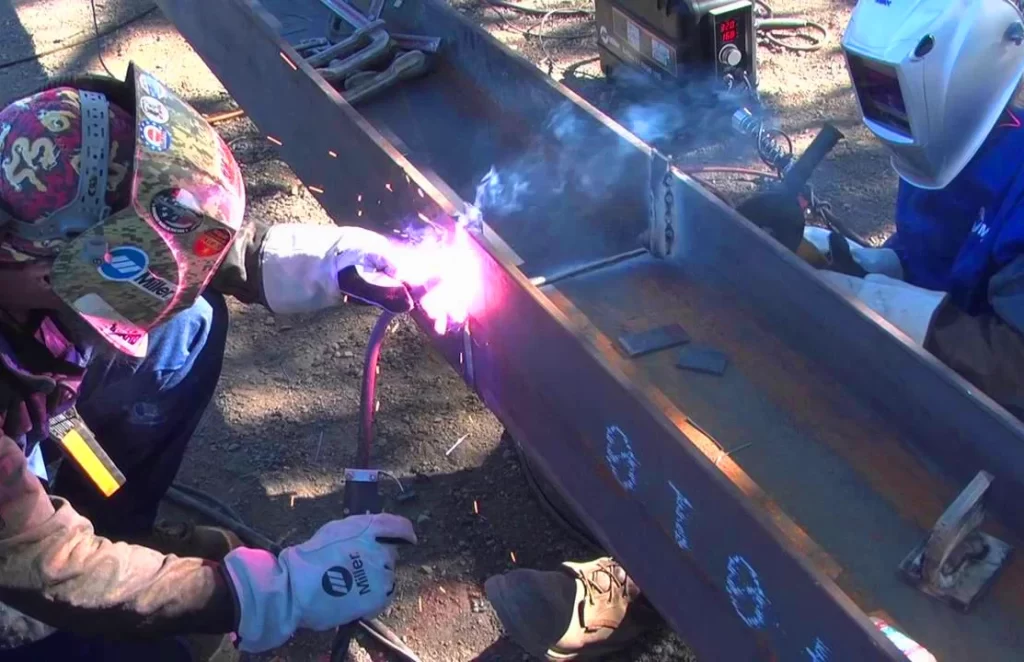
This welding method’s high welding speed and portability make it widely used in construction. Flux core welding can be readily performed outdoors, even in windy conditions, but dual shield variation can be effective within wind shelters.
When mechanized, dual shield welding can be used in most automobile and machine fabrication industries.
Since dual shield wire can be used for a range of alloys, plain carbon, stainless and duplex steels, flux-cored arc welding is also frequently used for surfacing and hardfacing.
Weldable Materials
Dual shield welding works well with most carbon steels, cast iron, stainless steel, and hard-facing/surfacing alloys. However, there are limitations in welding non-ferrous exotic metals, such as aluminum. So if you want to learn how to weld non-ferrous metals or what welding methods to use, feel free to check out our detailed article.
Transfer Types and Polarity – Globular or Spray Transfer
Globular and Spray Transfer are the most frequently used transfer methods. However, spraying arc is more prevalent among welders due to high deposition rates, good penetration, and aesthetic look.
You can opt for the globular method when choosing economical shielding gases such as pure CO2 since it offers low costs with higher penetration.
However, even though the globular transfer is suitable for thicker metals, you should expect a bit more spatter.
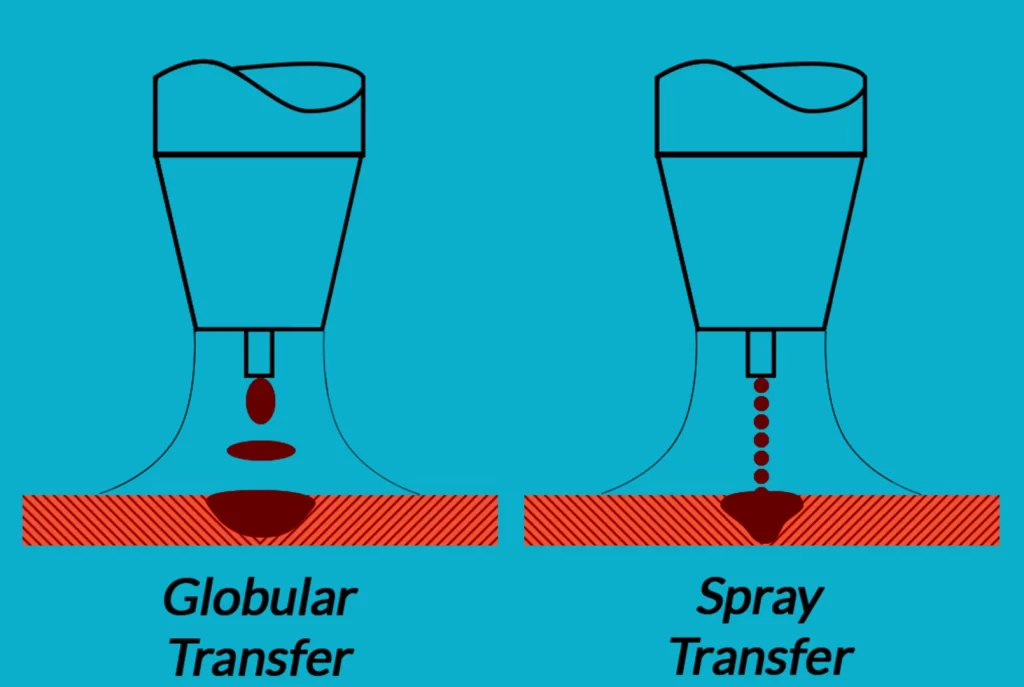
Regardless of the transfer method, most dual shield fluxed core electrode manufacturers recommend DC+ polarity.
Dual shield welding Pros & cons
Even though dual shield welding combines good sides of both flux core arc welding and MIG welding, it has its advantages and drawbacks. Since no welding method is perfect, let’s discuss the pros and cons of this variation.
Pros:
- Productivity:
Dual shield welding allows welding businesses to complete jobs quicker with high deposition rates. Experts believe that companies can save up to 60% of the total cost of depositing one lb of weld metal with this welding method.
- High deposition rates:
Spray transfer is a go-to welding arc option whenever you want to do the job efficiently. The dual shield welding process allows you to make a high deposit due to the relatively high current density.
- Deep penetration:
One of the most significant advantages of and the reason why welders choose dual shield wire, and shielding gases is the deeper penetration. As a result, you can reduce the leg dimensions and decrease the fillet size. That way, you can reduce the total weld metal required by as much as 50 to 60 percent. Remember that externally supplied gas such as CO2 can significantly impact the penetration.
- Welding positions:
Unlike MIG welding with solid wire, shielded FCAW works excellent in all welding positions. You get an increased speed on vertical welds without fear of droplets caused by the solid metal electrode. In addition, since flux-cored electrodes provide higher welding current when welding out-of-position, welders get better sidewall fusion and increased weld integrity. That way, you minimize the risks of expensive reworks on a project.
- Easy to learn:
Welders realize wire arc welding processes are usually easy to master and understand, and the shielded flux core arc welding is no exception. A flux electrode and a shielding flux welders get decent results with little practice. The final weld appearance is satisfying and forgiving, as you gain greater control and a smoother finish without creating porosity.
Cons:
- Fumes:
The flux-cored electrode produces hazardous toxic fumes. Short-term exposure can cause illnesses such as metallic fever, while breathing fumes can even cause lung cancer for the long term.
Therefore, you should always use welding protection gear such as a respirator when using the shielded FCAW method. In addition, since this welding process produces significantly more smoke than MMA or MIG welding, some welders find it hard to see the molten puddle.
- Filler wire
FCAW Consumable electrode can be somewhat more expensive compared to solid wires since you theoretically don’t need any shielding gas. However, the expenses rise once you opt to double shield the weld.
In addition, welders have to be cautious when storing flux core filler metal, since it is prone to defects when exposed to humidity. Also, make sure your filler metal matches the composition of the base metal.
- Welding limitations
Since shielded flux core is commonly used in welding structural steel and thicker metals, welding thinner metals than 20 ga is not practical. With higher penetration, you will easily burn through a thin metal sheet.
In addition, when using a multi-pass approach, you should always clean the slag formation. Trapped slag can impact the mechanical properties of the weld, eventually causing welding defects.
Shielded Flux Core Welding Tips
- Make sure you clean slag formation after every substantial pass
- Store your wire and choose adequate filler material
- During overhead welds, make sure you increase welding travel speed
- Knurled drive rolls ensure smooth wire feed with soft flux-cored wire
- When welding thinner metals, it is better to weld down vertically. For metals thicker than 1/4″ weld up
- When welding significantly thicker materials welders should opt for pure CO2 shielding gas
- When weld appearance is more crucial, you should opt for 75% argon and 25% carbon dioxide
- Make sure there is adequate ventilation to avoid health hazards when working inside
- When working with flat welds weld at 90 degrees and 10 degrees back, for T Joints angle should be 45 degrees while Lap joints require welds at 60-70 degrees
- Limit wire stick out
Resources:
- https://www.twi-global.com/technical-knowledge/faqs/flux-cored-arc-welding-fcaw
- https://www.weldingtipsandtricks.com/dual-shield.html
- https://weldingweb.com/vbb/threads/688581-Dual-shield-welding-Why
- https://www.esabna.com/shared/documents/litdownloads/cor-1183_dual_shield_flux_cored_wires_brochure_na_en.pdf
- https://www.weldingtipsandtricks.com/dual-shield.html





